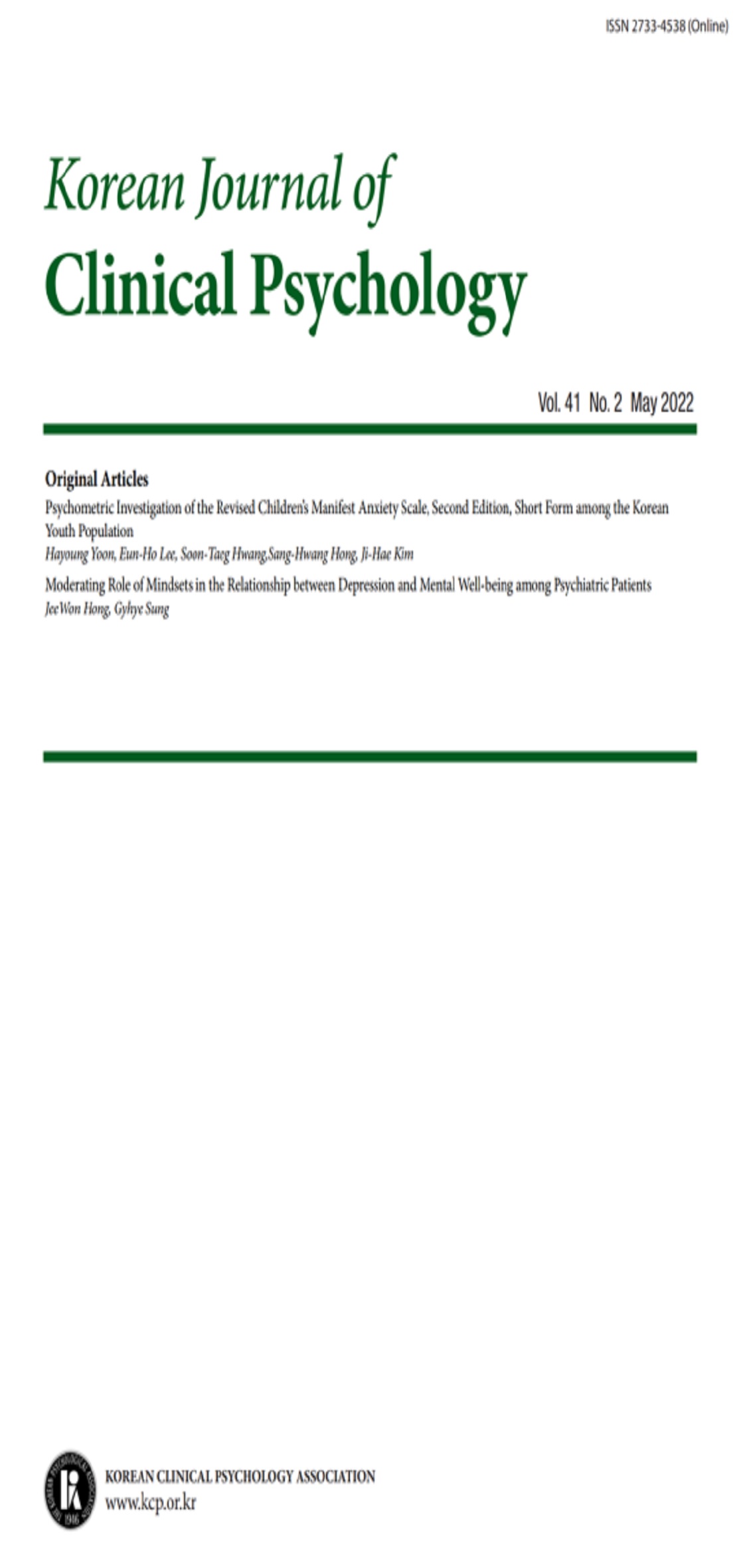open access
메뉴
open access
메뉴 E-ISSN : 2733-4538
E-ISSN : 2733-4538
본 연구는 Rapee(1997)의 부모 자녀 상호 작용 평가 척도를 토대로 우리나라 부모-자녀 상호 작용 평가 방식을 개발하고 신뢰도와 타당도를 검증하는데 목적을 두고 있다. 연구 대상은 아동 82명(정상 집단 아동 51명과 외현화 장애 집단 아동 15명, 내현화 장애 집단 아동 16명)과 그 어머니 82명 등 전체 164명이었다. 어머니가 옆에 앉은 상태에서 아동에게 인지적 과제를 수행하게 한 후, 어머니와 아동의 상호 작용을 5분 동안 비디오로 녹화하였다. 어머니와 아동의 상호 작용은 두 명의 평정자가 어머니와 아동의 행동을 각각 9점 척도 상에서 평정하게 하였다. 척도의 구성 타당도 검증을 위해 탐색적 요인 분석(exloratory factor analysis)을 한 결과, 어머니 행동 평정 척도의 9개 항목과 아동 행동 평정 척도의 6개 항목이 각각 2개 요인 구조로 분류되었다. 또한 척도의 내적 타당도를 확인하기 위해 평정 방법 외에도 어머니와 아동의 행동의 빈도를 통한 평가 방법을 함께 사용하여 두 방법 간의 상관을 분석하여 비교하였는데, 비슷한 항목에서 두 방법 간의 상관이 유의미한 것으로 나타났다. 이러한 결과에 근거하여 행동 평정 척도의 사용 가능성과 한계점, 제안점을 논의하였다.
The purpose of the study was to develop the Scale of Parent-Child Interaction Behavior in Korea, based on Rapee's Parent-Child Interaction Scale(1997) and examine its reliability and validity. The subject of this study consisted of 82 parent-child dyad (51 normal children, 15 externalizing problem children and 16 internalizing problem children). Children were given 5 tangram pulzzles to do in the presence of their mothers. The mother-child interaction was videotaped for 5 minutes. Two raters independently scored the parent and the child interaction behaviors, respectively. The mothers' behaviors were rated with each item of “Warmth” and “Involvement” on 9 point Likert Scale and children's behaviors were rated with each item of “Mood” and “Acceptance” on 9 point Likert Scale, respectively. The results were as follows. First, the Parent-Child Interaction Behavior Rating Scale had appropriate internal reliability. Second, factor analysis study of the Parent-Child Interaction Behavior Rating Scale confirmed that two factor model accounted best with mother and child, respectively. Third, the results obtained by the Parent-Child Interaction Behavior Rating Scale were compared to those by the frequency analysis of mother-child Interaction Behavior per 10 seconds. The correlation between the two methodologies about similar items was significant. The validity of Parent-Child Interaction Behavior Rating Scale is proved. The acquired results of this study successfully supported reliability, validity and clinical utility of Parent-Child Interaction Behavior Rating Scale.
(1992) 신뢰도 및 타당도 검증,
(2002) 지각된 부모의 양육행동과 초기 청소년의 우울 및 불안의 관계,
(1979) Parental representations and depression in normal young adults Journal of Abnorma Psychology,
(1981) Parental agreement-dis-agreement on child-rearing orientations and gender-related personality correlates in children,
(1997) Behavior problems in preschool children:Developmental and family issues,
(1994) Hard to-manage preschool boys family context and the stability of externalizing behavior Journal of Abnormal Child Psychology,
(1991) A parental rearing style questionnaire for use with adolescents Psychometric evaluation of the EMBU-A,
(1973) A Theory of Schizophrenic Development,
(1966) Patterns of parental child rearing and consequent vulnerability to cognitive disturbance Journal of Consulting Psychology,
(1994) Attention deficits and hyperactivity in children,
(1984) Boys who fight at home and school Journal of Consulting and Clinical Psychology,
(1977) Accelerating stimuli for two classes of coercive behaviors,
(1979) British Journal of Medical Psychology,
(1980) Development of a new inventory for assessing memories of parental rearing behavior Acta Psychiatry of Scandinavia,
(1997) The potential role of childrearing practice in the development of anxiety and depression Clinical Psychology Review,
(1985) Perceived parental acceptance-rejection and parental control among Korean adolescents,
(1990) Maternal beliefs about adaptive and maladaptive social behaviors in normal Journal of Abnormal Child Psychology,
(1959) A circumplex model for maternal behavior,
(1989) A comparison of parent and aggregate ratings from two instruments Journal of Research in Personality,
